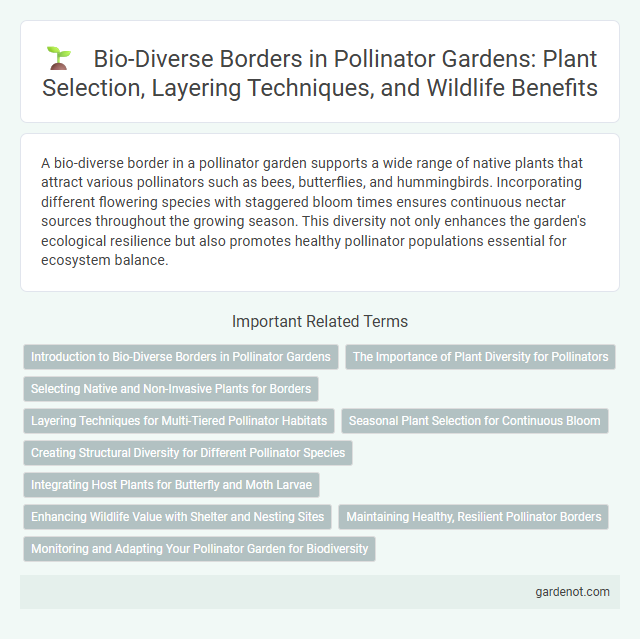A bio-diverse border in a pollinator garden supports a wide range of native plants that attract various pollinators such as bees, butterflies, and hummingbirds. Incorporating different flowering species with staggered bloom times ensures continuous nectar sources throughout the growing season. This diversity not only enhances the garden's ecological resilience but also promotes healthy pollinator populations essential for ecosystem balance.
Introduction to Bio-Diverse Borders in Pollinator Gardens
Bio-diverse borders in pollinator gardens incorporate a variety of native flowering plants, shrubs, and grasses that provide continuous blooms and nesting habitat throughout the seasons. These borders create essential ecosystems supporting a wide range of pollinators such as bees, butterflies, and hummingbirds by offering diverse nectar sources and shelter. Planting a mix of species with staggered flowering times enhances pollinator health and promotes ecological balance in garden environments.
The Importance of Plant Diversity for Pollinators
Plant diversity in a bio-diverse border supports a wide range of pollinators by providing varied nectar and pollen sources throughout the growing season. Native flowering plants, herbs, and shrubs create essential habitats that sustain bees, butterflies, and other pollinating insects, aiding in their survival and reproduction. Enhancing plant diversity also promotes ecological resilience and improves pollination efficiency, crucial for maintaining healthy ecosystems and agricultural productivity.
Selecting Native and Non-Invasive Plants for Borders
Choosing native and non-invasive plants for pollinator garden borders enhances local biodiversity and supports indigenous pollinator species. Native plants like purple coneflower, blazing star, and milkweed provide essential nectar and pollen sources while maintaining ecosystem balance. Incorporating carefully selected non-invasive species broadens bloom periods and plant diversity without disrupting native habitats.
Layering Techniques for Multi-Tiered Pollinator Habitats
A bio-diverse border in a pollinator garden utilizes layering techniques to create multi-tiered habitats that support a wide range of pollinators, from ground-nesting bees to butterflies and hummingbirds. Incorporating native grasses, flowering perennials, and shrubs at varying heights enhances nectar availability and shelter throughout the growing season. This strategic layering fosters a resilient ecosystem that boosts pollinator diversity and activity.
Seasonal Plant Selection for Continuous Bloom
A bio-diverse border in a pollinator garden enhances ecosystem health by supporting a wide range of insects and birds. Seasonal plant selection ensures continuous bloom from early spring to late fall, providing consistent nectar sources for pollinators. Incorporating native perennials, annuals, and flowering shrubs promotes resilience and maximizes habitat diversity throughout the growing season.
Creating Structural Diversity for Different Pollinator Species
A bio-diverse border in a pollinator garden enhances habitat complexity by incorporating a variety of plant heights, flowering times, and leaf textures to support diverse pollinator species such as bees, butterflies, and hummingbirds. Structural diversity provides shelter, nesting sites, and foraging resources that accommodate the unique needs of solitary bees, bumblebees, and nectar-feeding insects. Integrating native shrubs, herbaceous perennials, and flowering groundcovers stimulates pollinator activity and promotes ecosystem resilience.
Integrating Host Plants for Butterfly and Moth Larvae
A bio-diverse border in a pollinator garden enhances ecosystem resilience by integrating host plants essential for butterfly and moth larvae development. Native species like milkweed, fennel, and violet serve as critical larval food sources, supporting the complete life cycle of these pollinators. Incorporating a variety of host plants promotes higher butterfly and moth populations, contributing significantly to pollination and biodiversity.
Enhancing Wildlife Value with Shelter and Nesting Sites
A bio-diverse border in a pollinator garden significantly enhances wildlife value by providing essential shelter and nesting sites for various pollinators, including bees, butterflies, and birds. Incorporating native plants with diverse structural heights and dense foliage creates microhabitats that support breeding and protection from predators. This strategic planting fosters a resilient ecosystem, promoting biodiversity and sustaining pollinator populations crucial for plant reproduction.
Maintaining Healthy, Resilient Pollinator Borders
Maintaining healthy, resilient pollinator borders involves planting a diverse array of native flowering plants that provide continuous nectar and pollen sources throughout the growing season. Incorporating various flower shapes, colors, and bloom times supports a wide range of pollinator species, including bees, butterflies, and hummingbirds. Regularly removing invasive plants and minimizing pesticide use helps preserve the biodiversity and ecological balance essential for robust pollinator populations.
Monitoring and Adapting Your Pollinator Garden for Biodiversity
Regular monitoring of plant species and pollinator activity in your bio-diverse border ensures a thriving ecosystem that supports native bees, butterflies, and other beneficial insects. Implementing adaptive management practices based on seasonal observations helps maintain plant diversity and responds effectively to environmental changes or invasive species threats. Utilizing tools such as pollinator counts and soil health assessments promotes a resilient garden that maximizes habitat value and biodiversity.
Bio-diverse border Infographic

 gardenot.com
gardenot.com